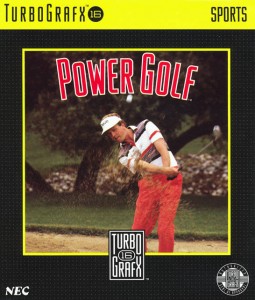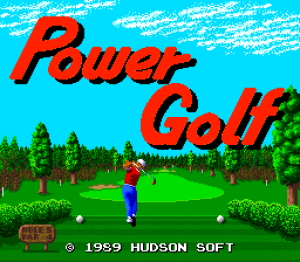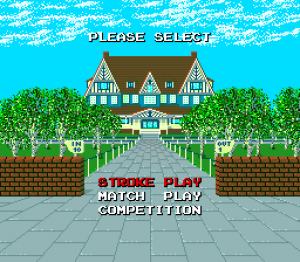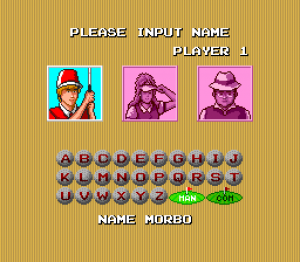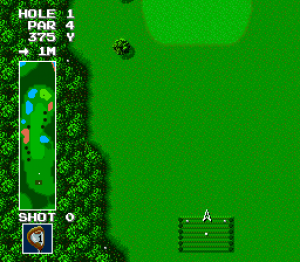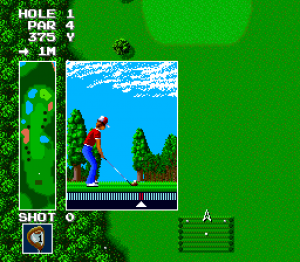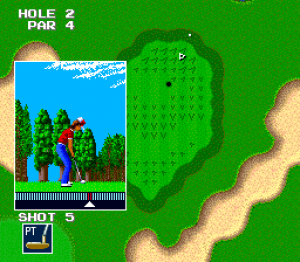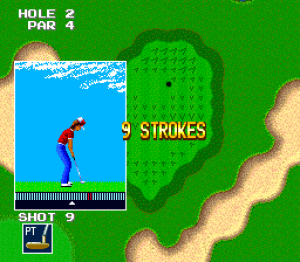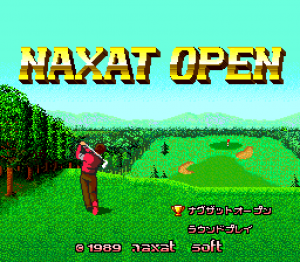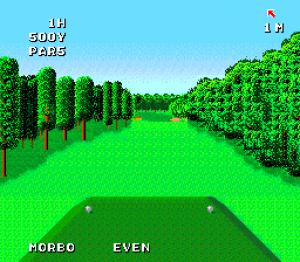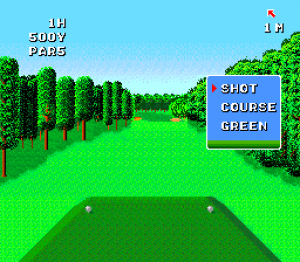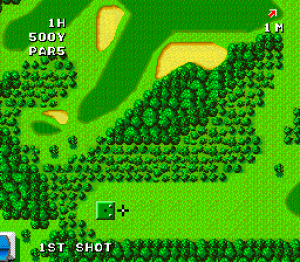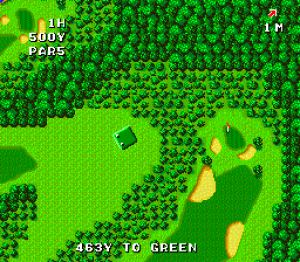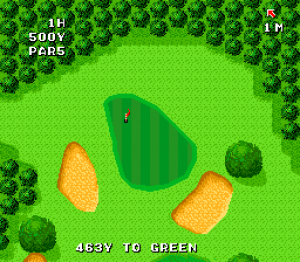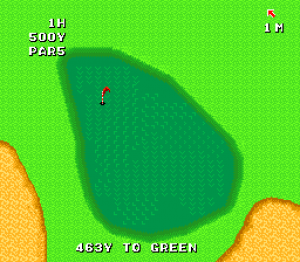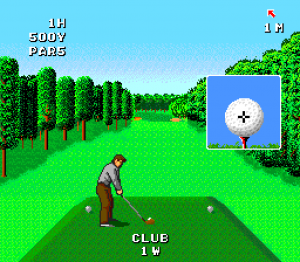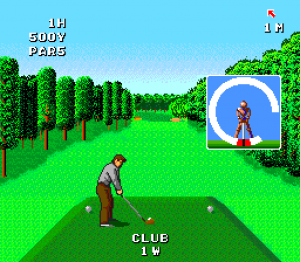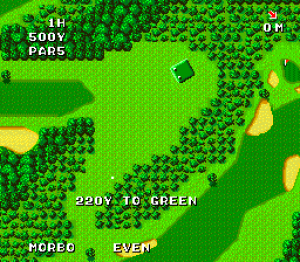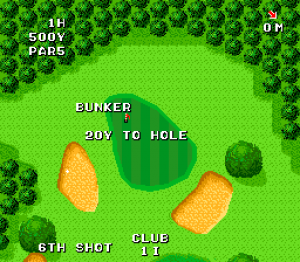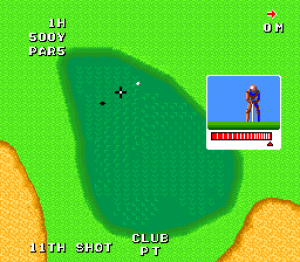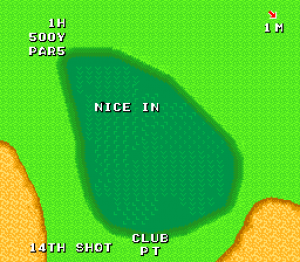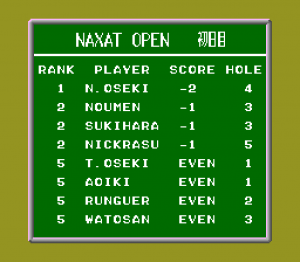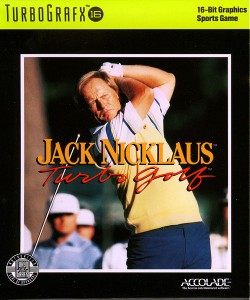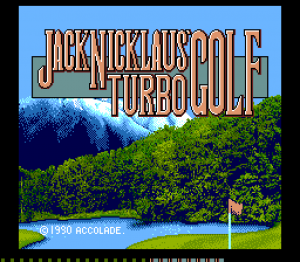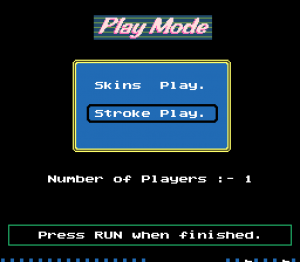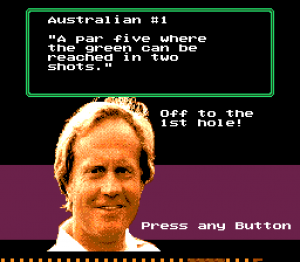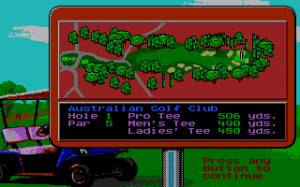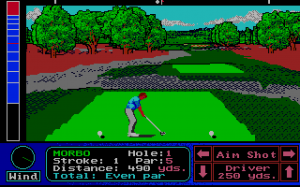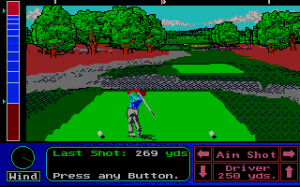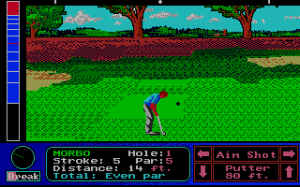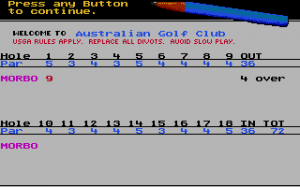Not many people remember the TurboGrafx-16. And it’s been justly forgotten, I think. I lived through the 16-bit console wars in the early 90s, and I don’t ever remember seeing ads for the system on TV. Then again, I live in Canada, so maybe Hudson Soft and NEC didn’t see any point in bothering with the Canadian market at all.
But from what I’ve read, their ads took on a distinct “Well, we were here first and we’re better so buy us!” tone. Accuracy of these statements aside, from looking through the TG16’s shoddy game library, you’d swear it was an 8-bit console. (EDIT: The TG-16 actually has an 8-bit CPU. The graphics processors are 16-bit.) Nobody really wanted to make games for the system, so most of the games that came out for it are Hudson Soft titles, and most of those are terrible. The only games I really enjoy on this system are the “Bonk” games. Those are the best 8-bit platformers you can play. It says a lot that they can be found on a 16-bit system.
I found three golf games for the TG16. Let’s load them up and play them.
“Power Golf”, 1989
Horrible, horrible game. Remember a few posts down when I said that legendarily bad games could no longer be released in this era due to better quality controls? I’m going to have to eat my words the more I think about that statement. I was just reminded yesterday of the legendarily bad Captain Novolin, so there you go. “Power Golf” isn’t legendary for being bad, but it’s just bad.
It has some elements that I personally do not like to see in a golf game, so let’s get those out of the way first. The most noticeable are the cartoony graphics and the bright and poppy happy music blaring incessantly out of the speakers.
Admittedly, the sound chip in the TG16 can produce higher quality sounds than the Sega Genesis. But look at these screenshots! They could have been taken from an NES game! I can’t get over how this system was sold as being better than the Genesis and Super Nintendo, yet the games made for it consistently had that 8-bit look.
When you start the game, you will see a view of the hole:
Pressing Select will allow you to use the direction pad to scroll up, down, left and right to view the entire hole. Pressing select again will show you a closeup of the putting green. Pressing Select a third time will return you to the view pictured above.
Use the direction pad to switch clubs (up and down) and to aim (left and right). The I button (as opposed to the II button) will bring up your power meter:
Here is where the game’s brokenness shines the most. It actually took me a while to figure out which button brought up this power meter because the button does not always work. And sometimes it is just slow. So press it, and wait. And then if you don’t see the power meter appear, press it again. But be careful, because the I button also starts your swing, and if you’re still trying to make the damn power meter appear while it actually does, you will have started your swing when you’re not ready for it.
Fuck, isn’t this fun!
The power meter is 3-button type. But it moves very fast, especially when the meter returns. And the hook and slice dynamics are reversed in this game from every other golf game I’ve reviewed except for “Golf” for the NES.
Also, the power meter will just appear any-old-where on the screen, which I find to be highly annoying. That breaks my concentration almost as much as the shitty repetitive music that can’t be stopped. The game is also very slow to respond in general, and feels like it was rushed out the door before it was really finished.
After you have made your shot, you will likely send your ball out of bounds because the power meter requires near pixel-perfect precision. An out of bounds shot requires a re-hit. And all of the shots you make will be very powerful. I think your golfer is some kind of roid monkey. Or maybe he’s got bionic arms or something. This also gets supremely annoying because it can be very hard to move the ball a short distance when you need to.
And when you get to 13 strokes, the game quits the hole for you and moves on to the next. Well, I guess that’s a sign that it doesn’t want me playing. Noted.
Making it onto the green doesn’t change much, except the buggy power meter requires one button-press less.
Oh, yay.
I think this game confuses hard-to-do with challenging. The latter can be fun, and is a requirement for a golf game. Hudson Soft got a reputation for squatting and shitting out games for this system, and “Gofer Plow” “Power Golf” is a great example of why they deserved this reputation.
“Naxat Open”, 1989
Another I-Can’t-Believe-It’s-Not-8-Bit game, but this one is a lot better than “Power Golf”. It’s still not anywhere near what I’d call a good golf video game. It’s a lot like “Ultra Golf” for the Game Boy. This one has slightly-less-annoying music playing constantly throughout the game compared to “Power Golf”, and the graphics are marginally better. There is only one mode of play (solo stroke play) and you only get the option to choose which clubs you’ll bring.
The I button is where the action is again. When you get to the main view like this, press I to see this menu pop up:
From there you can see views of the shot, a panning view of your hole, and the putting green.
Once you start your shot, you will see an aiming cross on the ball. Controls are pretty standard.
Press I again to get the power meter. It is the standard 3-button press type.
The power meter moves incredibly slowly, but you need to be quite precise to get a good shot out of it.
Getting on to the green will zoom in, and oddly, the power meter looks different but it requires the same amount of button presses.
As you can tell from my very poor finish, I wasn’t enjoying this game much and I didn’t make it into the final rankings. I only finished it for the sake of these lovely 8-bit 16-bit screenshots.
“Jack Nicklaus’ Turbo Golf”, 1990
Well, those graphics look a lot better! I’ve reviewed this game twice before, so I’ll only add that this is the best version of the game so far. The NES version was good, the Game Boy version was even good despite the limitations of the graphics there. So if you are fond of this particular game, this one beats those two in quality.
Hmmm… what happened to the impressive graphics?
At least that actually looks like Mr. Nicklaus…
Ah, so they blew their good graphics load on the title screen. Well, this game is a major improvement over the other two games I reviewed for the TG16. While you are playing the game, pressing the Run button will bring up the game menu. The I button is the action button.
The view is still 3D and rendering still takes a while. The physics are an improvement over the NES and Game Boy versions, though the controls are the same.
I was kind of distracted to see that the swing animation begins while you are still setting up your shot in the power meter. I can see how it’s more realistic this way, I’m just not used to it.
Here you are on the putting green. The slope and terrain of the green will affect your shot, but as far as I can tell there is no way to read or gauge this information. Also, the power meter on the putting green remains 3-button press just like it is on the rest of the course.
Nice putt?
You lied to me!
I can’t get over how the very best golf game for the TurboGrafx-16 still looks like it’s an 8-bit game from start to finish. If you think I’m exaggerating, load up “The Golf ’92” for the NES and play that for a while.
I honestly can’t recommend any of these games to any golf video game fans. If you really, really love “Jack Nicklaus Golf” for some reason, there’s a much better version to be found for the Super Nintendo. And compared to most everything I’ve reviewed here, the other two TG16 golf games are just crap.
